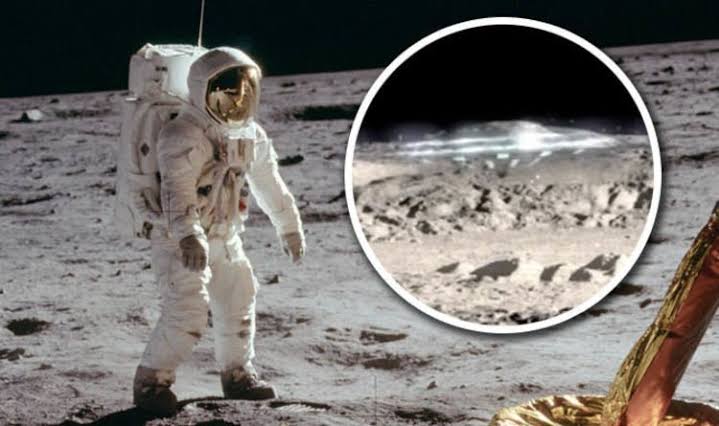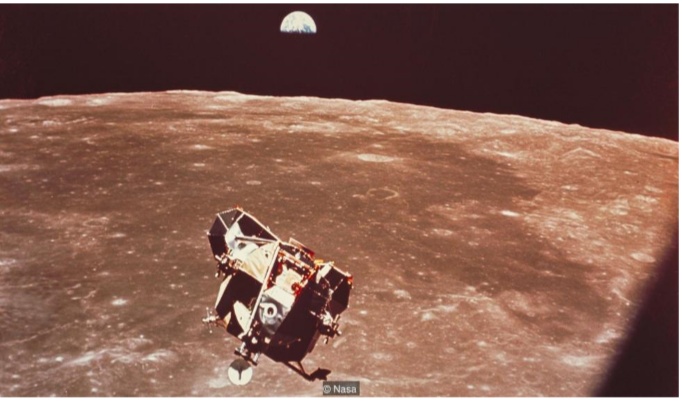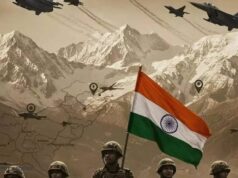Interesting Facts About APOLLO MISSION..2

Richard Hollingham collected other facts like :
The average distance from Earth to Moon is 382168 km. This distance is known with such accuracy because Apollo 11, 14 and 15 missions left behind devices called Laser Ranging Retroreflectors designed to reflect lasers aimed through telescopes from Earth.
It gave us improved understanding of the Moon’s orbit. They have also discovered that the Moon is getting further away from Earth – it’s currently receding at 38mm a year.
The speed record for the fastest re-entry and, therefore, the record for the fastest speed ever attained by humans was first set on 27 December 1968 by the crew of Apollo 8.
Frank Borman, Jim Lovell and Bill Anders re-entered the Earth’s atmosphere, travelling at 36,303 feet per second or 11.2 km per second. Apollo command module and its resin heat shield was designed to protect the crew from temperatures of up to 3,000C.
Borman says “From a physical standpoint it was the most arduous part of the mission because you’re pulling six gs for quite a long time and it becomes hard to breathe.It was like flying inside of a neon light or a blowtorch – it was the most dramatic part of the flight.”

Then the he Apollo 10 crew in May 1968, returned to Earth at 36,397 feet per second – that is 39,705km/h, the fastest record for human travel.
The astronauts brought back more than 360kg (790lb) of Moon rocks for study on Earth
The Apollo programme was conceived as a political challenge. Then it became an engineering challenge and finally, a scientific challenge to make sure the astronauts did something useful when they got there.
Key to this was training the Apollo crews in field geology. Thus apart from classroom sessions, the astronauts took part in field trips to Hawaii, Mexico, Iceland and Germany. They learned about rock formations, volcanoes and meteorite impact craters.
On the Moon, astronauts were equipped with hammers, scoops and drills.
The first (and only) geologist to visit the Moon was Harrison Schmitt. During his Apollo 17 mission, he discovered orange beads of rock – strong evidence of volcanic activity on the Moon. The crew brought back some 741 samples, weighing a massive 111kgs (244lb).
The 2,200 rock and soil samples collected on the Moon were taken to the lunar receiving laboratory in Houston. Although for Apollo 11 at least, the astronauts had to fill in a customs declaration first.
Moon rocks have since been donated to governments, museums or lent to scientific institutions for study. Others have remained sealed in their containers, untouched since they were collected.
Analysis of the samples has revealed the history of the Moon and provided compelling evidence that the Earth and Moon formed as a result of a giant impact between an early planet and another astronomical body.
Neil Armstrong and Buzz Aldrin were not permitted to stray far from the lander, their ride home. The furthest the crew walked was to a nearby crater, achieving a total distance of around half a mile.
But as the missions progressed, and the time spent on the surface increased, the astronauts walked further. Even in 1/6th gravity, however, bounding across the Moon was tiring and their range was limited.
During Apollo 15 in 1972, Dave Scott and Jim Irwin got to drive the first lunar rover. With a maximum speed of 16km/h, the electric vehicle carried them some 6.4 km
“The rover handles quite well… I can manoeuvre pretty well,” reported Scott to mission control. “It negotiates small craters quite well but it feels like we need the seatbelts.”
The lunar driving record is still held by the last man on the Moon, Gene Cernan. During his Apollo 17 landing with Harrison Schmitt, he notched-up 35km on the clock – travelling a maximum of 6.4 km from the spacecraft.

On foot and by rover, the Apollo astronauts covered some 60 miles of the lunar surface
Although the lunar module proved to be a great spacecraft, as a habitation module it was far from comfortable. The bulky cylinder of the ascent engine cover – rising like a barrel in the middle of the cabin – meant there was little floor space.
Armstrong attempted to sleep on the engine cover and Aldrin on the floor.
“The window shades did not completely block out light, the cabin was illuminated by a combination of light through the shades, warning lights and display lighting,” Armstrong complained.
“The noise from the glycol pumps was then loud enough to interrupt sleep,” he added. “The lunar module pilot [Aldrin] estimated that he slept fitfully for perhaps two hours and the commander did not sleep at all.”
During later missions, astronauts slept in their underwear in hammocks. Nevertheless, with all the excitement of being on the Moon, only a few reported getting a good night’s sleep.

The lunar lander was a brilliant piece of engineering – but it had few creature comforts for its two-man crew
But it wasn’t the most uncomfortable. Splashing down at night in the Pacific Ocean, the spacecraft tipped upside down, leaving the astronauts hanging in their seats.
“The spacecraft was a lousy boat,” Borman says. “We had to wait about two hours till daylight because the Navy didn’t want to put divers in when there were sharks.”
“I got seasick and threw-up all over Anders and Lovell,” he says. “I still hear about that to this day.”
After the intensity of launch, some astronauts felt that travelling to the Moon was pretty dull.
“Three and a half days we had nothing to do,” says Apollo 15 command module pilot, Al Worden. “All we had to do was wait till we got to the Moon and that’s a pretty boring time.”

The crew had three and a half mostly uneventful days on the journey between the Earth and the Moon.




